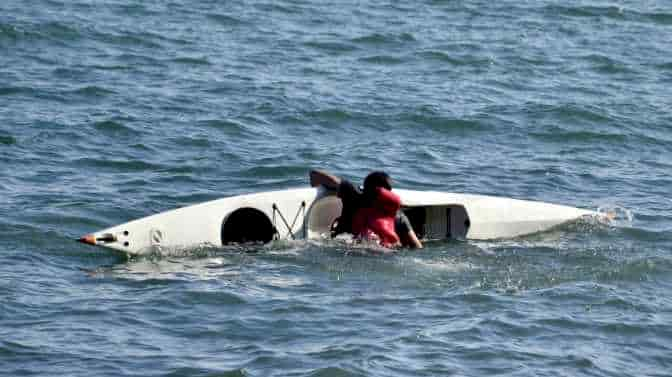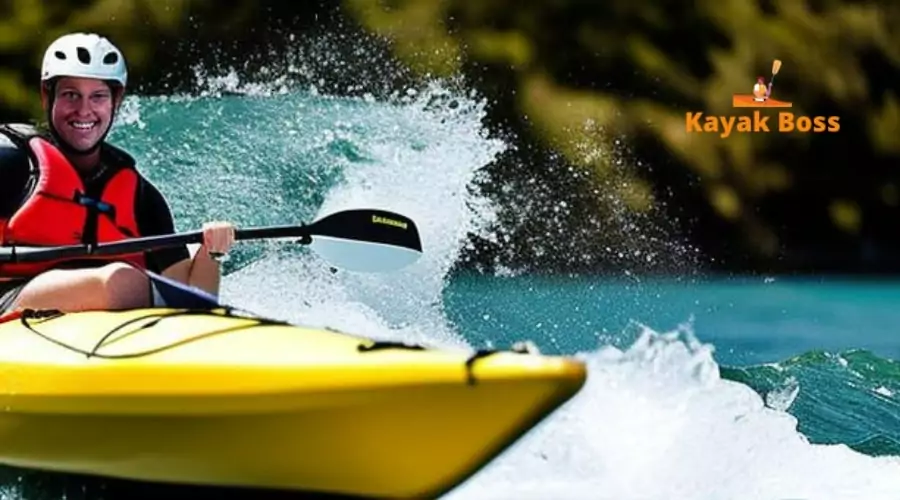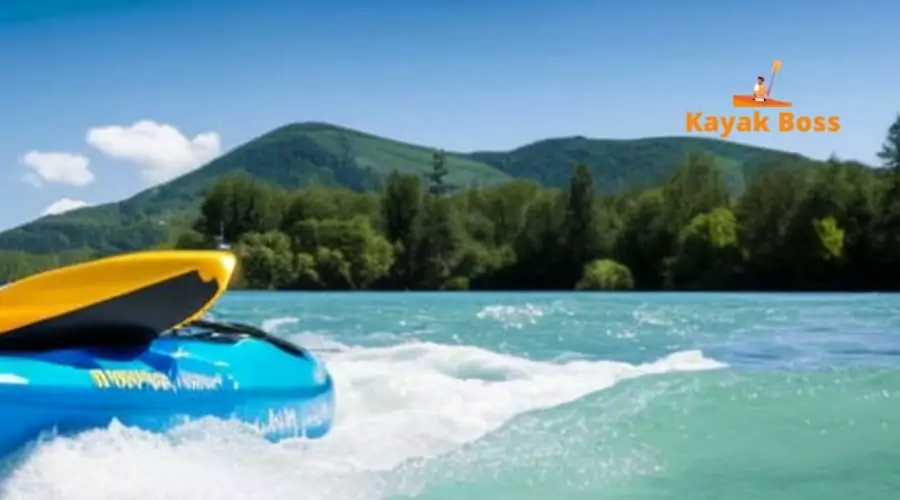No, a sit-on-top kayak will not sink. Sit-on-top kayaks are designed to be unsinkable and self-bailing due to the open hull design. The hull is constructed with multiple compartments that allow water to pass through while keeping passengers dry.
These kayaks are also equipped with scupper plugs, which can be opened or closed depending on weather and water conditions. As long as all of the scupper plugs remain in place, no water will enter the boat and it will not sink.
Even if some of the plugs become dislodged during use, the buoyancy chambers will still keep you afloat until you reach the shore or help arrives.
When you’re out on the water, one of your biggest worries is whether or not your kayak will sink. After all, no one wants to be stranded in the middle of a lake. Fortunately, if you have a sit-on-top kayak, there’s no need to worry!
Sit-on-top kayaks are designed with an open cockpit area that allows for good drainage and ventilation. This helps to prevent any water from pooling inside the hull which can cause it to sink.
The design also ensures that any small amounts of water that do get into the boat can easily drain out without causing too much damage or instability.
Additionally, these types of kayaks are often made with multiple air chambers underneath the decking which help provide additional buoyancy in case something does go wrong while on the water.
In addition to their inherent stability and buoyancy, sit-on-top kayaks generally offer some other advantages over traditional closed-top designs as well. They tend to be easier for beginners as they don’t require quite as much effort when paddling due to their open design allowing more efficient paddle strokes compared with traditional enclosed cockpits.

Are Sit-On-Top Kayaks Unsinkable?
When it comes to kayaking, one of the most important questions is whether or not a particular type of kayak is unsinkable. This question can be particularly pertinent for those who are new to the sport and want to make sure that they stay safe while out on the water. For many people, the answer lies in whether or not they choose a sit-on-top kayak.
So, are sit-on-top kayaks truly unsinkable? The short answer is no—sit-on-top kayaks are not unsinkable. However, it’s important to note that although they may take on some water if overturned or filled with cargo, these boats generally remain buoyant enough so that you won’t sink if you capsize them.
In other words, while they may still require some effort from you to right yourself again after capsizing and bail out any excess water inside your boat, a sit-on-top Kayak should still keep you afloat even when fully submerged in deep waters.

Will Sit in Kayaks Sink?
When it comes to kayaking, one of the biggest questions is whether or not a kayak can sink. While there are different types of kayaks and some are designed to be more buoyant than others, no kayak is completely unsinkable.
This means that if you sit in your kayak for too long or take on too much water, then it could potentially sink beneath you.
So what causes a kayak to become submerged? A number of factors can increase the risk of sinking including taking on water from rain, and waves, paddling hard in rough waters, or simply overloading the boat with supplies and/or people.
The main factor that contributes to a sit-in kayak sinking is when too much weight has been loaded into it for its intended capacity.
Overloading any type of vessel will cause its stability and buoyancy levels to decrease and make it more vulnerable to taking on water which can quickly lead to capsizing and submergence (especially if you’re out in choppy waters).
How Do I Keep My Kayak from Sinking?
If you’ve recently decided to take up kayaking, one of your biggest concerns is likely keeping your kayak from sinking. After all, no one wants to be stranded in the middle of a lake or river with a hull full of water! Fortunately, there are several steps you can take to make sure that doesn’t happen.
First and foremost, it’s important to make sure that any drain plugs are firmly secured before launching your kayak into the water. Many modern-style kayaks come equipped with self-bailing systems which allow for easy drainage through holes at either end of the vessel after taking on water, but these need to be sealed prior to use in order for their work properly – so always remember to double-check those drain plugs!
Another key factor when it comes to preventing sinking is making sure that your weight distribution is correct while paddling.
Generally speaking, heavier items should be placed toward the center of the boat while lighter ones should remain nearer the bow (front) and stern (back). This will help ensure that your kayak maintains its balance on the surface and won’t become flooded if waves start crashing over its sides.
How Stable are Sit-On-Top Kayaks?
The stability of a sit-on-top kayak is often overlooked when it comes to purchasing one. But this type of kayak can be just as stable, if not more so, than other types of kayaks. Sit-on-top kayaks are incredibly versatile and they offer a wide range of features that make them an ideal choice for many paddlers.
One factor contributing to the stability of sit-on-top kayaks is their flat hull design. This allows the boat to have minimal contact with the water’s surface, providing greater balance while in motion and making it easier to stay upright in windy or choppy conditions.
Additionally, these kayaks typically have wider cockpits which provide more room for your legs and feet ensuring you feel secure throughout your journey.
With your legs spread out evenly on either side, you can easily shift your weight from side to side allowing for faster turns and better agility when navigating through tight spaces or rapids.
Another advantage of sit-on-top designs is that they tend to be self-bailing which means any water that enters through waves will quickly escape via multiple drainage holes located around the cockpit area.
Will my Kayak sink?
How to Sit on a Sit-on-Top Kayak
Sitting on a sit-on-top kayak is one of the most popular ways to enjoy a day out on the water. Not only does it provide an enjoyable experience, but it’s also easy to learn and can be mastered with just a few tips and tricks.
Here are some essential steps for getting comfortable in your sit-on-top kayak so that you can have a great time paddling around.
1. Start With The Right Gear: Before you even get into your kayak, make sure you have all the necessary safety gear such as life jackets and other items like whistles or flares in case of emergency. It’s important to stay safe while you paddle!
2. Choose Your Seating Position: There are two main seating positions when it comes to sit-on-top kayaks, high seat mode or low seat mode, so decide which one is more comfortable for you before getting into the boat.
High seat mode will give you more stability whereas low seat mode gives better control over turning and manoeuvring the boat.

Sit on Top Kayak for Sale
If you’re in the market for a kayak, there’s no better style to consider than a sit-on-top kayak. These versatile boats are perfect for recreational paddlers and serious anglers alike, offering plenty of features and benefits that make them an ideal choice for anyone who loves to spend time out on the water.
Here we will take a look at some of the reasons why you should consider purchasing a sit-on-top kayak, as well as what types are available and how to choose the best one for your needs.
One of the main advantages of choosing a sit-on-top kayak is that they offer stability and comfort over other styles, particularly when it comes to fishing or leisurely paddling trips.
Their wide hull design helps keep you upright so that you can easily reach into your tackle box or enjoy an uninterrupted view while cruising downriver. In addition, their open design allows air circulation around your body which keeps you comfortable even during hot summer days out on the water.
How to Sit on a Kayak
Kayaking is a great way to explore the outdoors and have fun! Whether you’re out for just an hour or a day-long excursion, it’s important to know how to properly sit on your kayak. To ensure your comfort, safety, and paddling efficiency, here are some tips on how to sit in a kayak:
1. Find the Right Seat Position: The first step to sitting in a kayak correctly is finding the right seat position. You want your seat positioned so that it allows your legs and feet a full range of motion while still allowing you access to all of the necessary controls. If you’re using an adjustable seat, make sure it is set up according to your body size and weight.
2. Put On Your PFD (Personal Flotation Device): Always wear a personal flotation device when kayaking! This will help keep you safe if anything unexpected happens during your outing such as falling into the water or capsizing in rough waters. Make sure that once you put it on, all straps are snugly secured around your body for optimal buoyancy support in case of emergency scenarios like the one mentioned previously.
What Color Kayaks Attract Sharks
Are you planning to go kayaking this summer? If so, it’s important that you know what color kayaks attract sharks. When out in the open water, a shark can easily mistake a brightly colored kayak for its prey – which can be an incredibly dangerous situation.
To ensure your safety and peace of mind while paddling on the open seas or ocean waters, read through this blog post for details about what colors should be avoided when selecting a kayak. First off, it’s important to note that any bright colors have the potential to attract sharks. This includes neon yellow, orange, and green as well as fluorescent red and blue shades.
These are all distinct hues that stand out from their surroundings – making them easy targets for curious predators such as sharks.
Additionally, these bright colors may also resemble food sources such as bait fish or other marine life that normally swim near shorelines or within shallow depths where many types of shark species travel in search of food.
If you want to minimize your chances of attracting predators while out on the water in your kayak, try sticking with solid dark tones like navy blue or hunter green instead of flashy shades such as pink or lime green.
What Color Kayak is Safest
When it comes to choosing the ideal color for a kayak, safety should be your top priority. Kayaks come in all sorts of colors and designs, but if you’re looking for the safest option possible, there are some key factors to consider. The most important factor when selecting a kayak color is visibility on the water.
Bright colors like red or yellow stand out more than darker colors and can help make others aware of your presence. Additionally, white reflects light well so it’s often considered one of the best options as it makes you easier to spot from both close range and far away.
Another factor that you’ll want to keep in mind when picking out your kayak color is its ability to blend into its surroundings.
If you plan on taking your kayak out during hunting season, then an earth-tone camo print may be right up your alley since it helps camouflage with nature better than brighter colors would.
If fishing is more up your alley though, then opt for lighter shades that match natural elements such as sand or grass so that fish won’t see you coming from afar! Finally, don’t forget about personal preference!
Do Sharks Attack Kayaks
If you’ve ever been kayaking, chances are you’ve heard tales of people being attacked by sharks. It’s an image that evokes fear and dread in many who venture onto the water, but is it actually something to worry about? Is there any truth behind the rumor that sharks will attack a kayak or its paddler?
The short answer is yes
Though thankfully such incidents remain rare. The first recorded incident of a shark attacking a kayaker was reported in San Francisco Bay back in 2009. A great white shark lunged at the boat, sinking its teeth into the tail end while sending waves of panic through both paddlers onboard.
Fortunately, they were able to make it safely back to shore and no one was hurt; however, this event set off alarm bells for all those using small vessels on open waters around the world.
So why did this happen and could it be repeated? Well according to experts, great whites may mistake these smaller boats for their own prey given their close resemblance in size and shape when viewed from below — particularly if they contain dark colors or objects dangling over the sides like fishing lines or bait buckets.
Conclusion
Have you ever wondered if a sit-on-top kayak will sink? Well, the answer is no! Sit-on-top kayaks are designed to be self-bailing and are made from materials that have buoyancy.
This means that water can enter the kayak without it sinking. The hull also consists of several air chambers which add additional stability and buoyancy so that even if there is a hole in the boat, it won’t completely fill up with water and sink. Plus, you can always add extra air into these chambers for added protection.
So don’t worry – your sit-on-top kayak isn’t going anywhere anytime soon!
